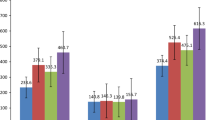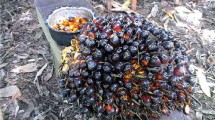Abstract
In the recent years, ethnic foods have become an important trading segment in Europe due to the increasing demand of immigrant people. Generally, the ethnic foods are produced in the native country, and their features not necessarily meet the European food standards. African red palm oil is an ethnic food produced and consumed in the West Africa since ancient times by using traditional techniques; it is extremely different from the better-known refined palm oil produced in the Southeast Asia. In this study, five commercial African red palm oils, purchased from ethnic food stores of Dublin (Ireland) and Rome (Italy), have been investigated. Label on the oil packages was found to be low conformed to European rules. The basic commercial parameters (free acidity, peroxide value and DOBI index) have evidenced very high level of free fatty acids, ranging from 7.6 to 13.4%. Likewise high amount of mono- (0.7%) and di-glycerides (5.8%) were obtained averagely. Peroxide value was averagely 9 meqvO2/kg evidencing a good oil oxidative resistance. Analyzed oils showed considerable content of nutraceuticals, especially squalene (487 mg/kg on average), total phenols (161 mg/kg), carotenoids (453 mg/kg), tocopherols (116 mg/kg) and tocotrienols (387 mg/kg). This wealth of phytochemicals makes the African virgin palm oil a good dietary fat, appealing also for the European consumers. However, a restructuring of the manufacturing process is recommended to improve oil quality and limiting the hydrolytic reactions.


Similar content being viewed by others
References
Omar OE, Hirst A, Blankson C (2004) Food shopping behavior among ethnic and non-ethnic communities in Britain. J Food Prod Mark 10(4):39–57
Murphy DJ (2014) The future of oil palm as a major global crop: opportunities and challenges. J Oil Palm Res 26(1):1–24
Food and Agriculture Organization (FAO) FAOSTAT online statistical service http://faostat.fao.org. Accessed Aug 2016
Fitzherbert EB, Struebig MJ, Morel A, Danielsen F, Brühl CA, Donald PF, Phalan B (2008) How will oil palm expansion affect biodiversity? Trends Ecol Evol 23:538–545
Carrere R (2010) Oil palm in Africa: past, present and future scenarios. World Rainforest Movement, Montevideo
Huddleston P, Tonts M (2007) Agricultural development, contract farming and Ghana’s oil palm industry. Geography 92:266–278
Poku K (2002) Small-scale palm oil processing in Africa. In: Agricultural services bulletin, vol 148. FAO, Rome, Italy
Vincent CJ, Shamsudin R, Baharuddin AS (2014) Pre-treatment of oil palm fruits: a review. J Food Eng 143:123–131
Ituen EUU, Modo IVO (2000) The effect of the fermentation period on palm oil production in eastern Nigeria, using traditional methods. Indig Knowl Dev Monit 8:7–12
Sambanthamurthi R, Sundram K, Tan Y (2000) Chemistry and biochemistry of palm oil. Prog Lipid Res 39:507–558
Gee PT (2007) Analytical characteristics of crude and refined palm oil and fractions. Eur J Lipid Sci Tech 109(4):373–379
Zulkurnain M, Lai OM, Latip RA, Nehdi IA, Ling TC, Tan CP (2012) The effects of physical refining on the formation of 3-monochloropropane-1, 2-diol esters in relation to palm oil minor components. Food Chem 135(2):799–805
Mortensen A (2005) Analysis of a complex mixture of carotenes from oil palm (Elaeis guineensis) fruit extract. Food Res Int 38:847–853
Al-Saqer JM, Sidhu HS, Al-Hooti SN, Al-Amiri HA, Al-Othman A, Al-Haji L, Mansour IB, Minal J (2004) Developing functional foods using red palm olein. IV. Tocopherols and tocotrienols. Food Chem 85:579–583
Loganathan R, Selvaduray KR, Nesaretnam K, Radhakrishnan AK (2010) Health promoting effects of phytonutrients found in palm oil. Malays J Nutr 16:309–322
Odia OJ, Ofori S, Maduka O (2015) Palm oil and the heart: a review. World J Cardiol 7(3):144–149
Sundram K, Khor HT, Ong ASH, Pathmanathan R (1989) Effect of dietary palm oils on mammary carcinogenesis in female rats induced by 7, 12-dimethylbenz (a) anthracene. Cancer Res 49:1447–1451
Yam ML, Hafid SRA, Cheng HM, Nesaretnam K (2009) Tocotrienols suppress proinflammatory markers and cyclooxygenase-2 expression in RAW264.7 macrophages. Lipids 44:787–797
Budin SB, Othman F, Louis SR, Abu M, Bakar A, Mohamed J (2009) The effects of palm oil tocotrienol-rich fraction supplementation on biochemical parameters, oxidative stress and the vascular wall of streptozotocin-induced diabetic rats. Clinics 64:235–244
Sen CK, Rink C, Khanna S (2010) Palm oil-derived natural vitamin E α-tocotrienol in brain health and disease. J Am Coll Nutr 29:314–323
Ong ASH, Goh SH (2002) Palm oil: a healthful and cost-effective dietary component. Food Nutr Bull 23(1):11–22
European Union Commission (1991) Regulation EEC 2568/91 on the characteristics of olive oil and olive-residue oil and on the relevant methods of analysis. Official Journal of European Communities L248
Panfili G, Fratianni A, Irano M (2003) Normal phase high-performance liquid chromatography method for the determination of tocopherols and tocotrienols in cereals. J Agric Food Chem 51:3940–3944
Swoboda PAT (1982) Bleachability and the DOBI (determination of bleachability index in palm oil). PORIM Bulletin, Kuala Lumpur
De Leonardis A, Macciola V (2012) Heat-oxidation stability of palm oil blended with extra virgin olive oil. Food Chem 135:1769–1776
De Leonardis A, Macciola V, De Felice M (1998) Rapid determination of squalene in virgin olive oils using gas-liquid chromatography. Ital J Food Sci 10(1):75–80
De Leonardis A, Angelico R, Macciola V, Ceglie A (2013) Effects of polyphenol enzymatic-oxidation on the oxidative stability of virgin olive oil. Food Res Int 54(2):2001–2007
Panfili G, Fratianni A, Irano M (2004) Improved normal phase high-performance liquid chromatography procedure for determination of carotenoids in cereals. J Agric Food Chem 52:6373–6377
Mouly PP, Gaydou EM, Corsetti J (1999) Determination of the geographical origin of Valencia orange juice using carotenoid liquid chromatographic profiles. J Chromatogr A 844:149–159
LARN (2014) Livelli di Assunzione di Riferimento di Nutrienti ed energia per la popolazione italiana. Online service http://www.sinu.it/html/cnt/larn.asp
Fratianni A, Caboni MF, Irano M, Panfili G (2002) A critical comparison between traditional methods and supercritical carbon dioxide extraction for the determination of tocochromanols in cereals. Eur Food Res Technol 215:353–358
Mignogna R, Fratianni A, Niro S, Panfili G (2015) Tocopherol and tocotrienol analysis as a tool to discriminate different fat ingredients in bakery products. Food Control 54:31–38
Sheppard AJ, Pennington JAT, Weihrauch JL (1993) Analysis and distribution of vitamin E in vegetable oils and foods. In: Packer L, Fuchs J (eds) Vitamin E in health and disease. Dekker, New York, pp 9–31
Parliament E (2011) Regulation (EU) 1169/2011 of the European Parliament and of the Council of 25 October 2011 on the provision of food information to consumers. Off J Eur Commun L304:18
Carey MC, Small DM, Bliss CM (1983) Lipid digestion and absorption. Annu Rev Phys 45(1):651–677
Boden G (2011) Obesity, insulin resistance and free fatty acids. Curr Opin Endocrinol Diabetes 18(2):139–143
De Leonardis A, Cuomo F, Macciola V, Lopez F (2016) Influence of free fatty acid content on the oxidative stability of red palm oil. RSC Adv 6(103):101098–101104
Tan CH, Ghazali HM, Kuntom A, Tan CP, Ariffin AA (2009) Extraction and physicochemical properties of low free fatty acid crude palm oil. Food Chem 113(2):645–650
Siew WL, Gee PT (2001) Deterioration of bleachability index (DOBI). Inform 12:1183–1187
Lo SK, Tan CP, Long K, Yusoff MSA, Lai OM (2008) Diacylglycerol oil—properties, processes and products: a review. Food Bioprocess Technol 1(3):223–233
Fratianni A, Albanese D, Mignogna R, Cinquanta L, Panfili G, Di Matteo M (2013) Degradation of carotenoids in apricot (Prunus armeniaca L.) during drying process. Plant Food Hum Nutr 68:241–246
Aggarwal BB, Sundaram C, Prasad S, Kannappan R (2010) Tocotrienols, the vitamin E of the 21st century: its potential against cancer and other chronic diseases. Biochem Pharmacol 80:1613–1631
World Health Organization (2009) Global prevalence of vitamin A deficiency in populations at risk 1995–2005: WHO global database on vitamin A deficiency
Ng MH, Choo YM, Ma AN, Chuah CH, Ali HM (2004) Separation of vitamin E (tocopherol, tocotrienol and tocomonoenol) in palm oil. Lipids 39:1031–1035
Author information
Authors and Affiliations
Corresponding author
Ethics declarations
Conflict of interest
The authors declare no conflict of interest.
Compliance with ethics requirements
This article does not contain any studies with human or animal subjects.
Rights and permissions
About this article
Cite this article
De Leonardis, A., Macciola, V., Niro, S. et al. Limits and potentials of African red palm oils purchased from European ethnic food stores. Eur Food Res Technol 243, 1239–1248 (2017). https://doi.org/10.1007/s00217-016-2839-1
Received:
Accepted:
Published:
Issue Date:
DOI: https://doi.org/10.1007/s00217-016-2839-1




